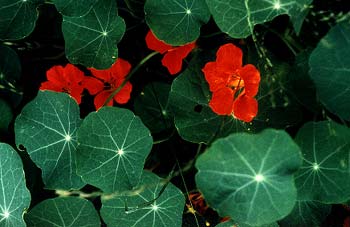
Trailing Single Nasturtiums
"I feel the breath of the summer night,
Aromatic fire:
The trees, the vines, the flowers are astir
With tender desire."
-Elizabeth Stoddard
(1823-1902)
(1823-1902)
I will have a long narrow garden down an alley slope eventually, but not right away. In the meantime I wanted something bright though temporary that would strangle the weeds & fill the area prettily. I planted a packet of "mixed" trailing single nasturtium seeds along the alley. The promise of "mixed" colors turned out to be 90% red-orange with a couple yellows tossed in, seed packagers being such inveterate liars. Although a vining annual nice for temporary fill-in in a low-maintenance spot, a few do always come back for at least a couple years, either from self-seeding or from some of the root surviving the winter & generating new vines in spring.
Nasturtiums were among the first things I ever planted as seeds when I was a child. My sister, cousins, & I planted them every year around stumps amidst the half wild Yarrows. The nasturtiums were with us all summer long, but always a little bit "banished" from the main gardens. There were no restrictions on what we kids did with them; we could pick them or not, we could water them or not. They called for little or no attention to become huge creeping vines filling up an area with attractive round leaves & bright blossoms.
So I poked these seeds in the ground along the alley with a sense of nostalgia, also looking forward to having the flowers to snatch a few at a time to add to salads. They grew rapidly & in July & early August were at their best, very wonderful & healthy. Neighbor children ran into the alley & came back with handfuls of blossoms. The nasturtiums more than met their purpose of filling the area with flowers in a jiffy.
However, by the middle of August they became infested with black aphids. Nasturtiums seem to have been invented specifically for the enjoyment of aphids, & suddenly it was time to shorten this annual's name from Nasturtium to merely Nasty.
I could've soaped the backs of the leaves & gotten rid of the majority of the aphids, or turned loose even more ladybugs. But it wasn't worth the trouble. I pulled out the worst infested sections & tossed them in the middle of the gravelled road to dry out & die. Another section closer to the head of the alley had the most sunlight with the least water & was slower to become infested so I left those a while longer.
I decided not to plant them again, partly because next year the bee balms & other hardy perennials along that alley will be spreading, & partly because there's just no keeping the aphids off them. That's probably why when we were kids we were encouraged to plant them as far away from important gardens as possible.
However, I could not resist establishing dwarf variegated nasturtiums in another roadside garden. They are non-trailing, low-growing, compact, & very restrained.